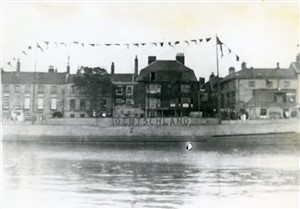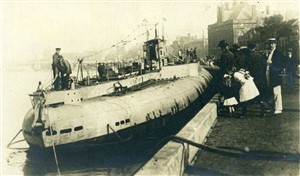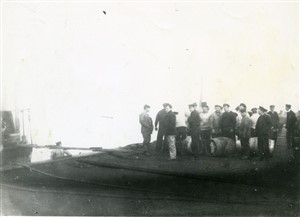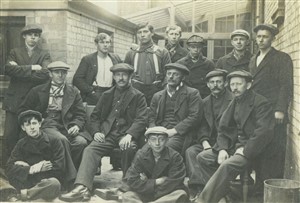The Deutschland

The Deutschland on South Quay

Curious onlookers along South Quay, Yarmouth in 1919 viewing the 'Deutschland'

British crew of captured German submarine at Great Yarmouth

Fourteen members of the crew rescued from the wrecked 'SS Rijm' of Norway in 1915
A German WW1 submarine on South Quay
By Thomas Flynn
The British naval blockade of Germany lasted from 1914-1919. Its aim was to prevent Germany from resupplying food and other resources through its already limited access points to a port through the North Sea. The role which the German U-boats, such as the Deutschland had was to try and break the blockade and allow Germany to resupply in order to continue its war effort. This ultimately failed and one of the operating factors in Germany’s loss was the starvation of almost 800,000 civilians.
The Deutschland began her life in March 1916 as one of two U-151-class unarmed merchant submarines, tasked with blockade running to resupply Germany. On its first voyage to the USA she took cargo worth $1.5 million and returned to Germany with materials for war. But by February 1917 the Imperial German Navy converted her into a U-155-class, meaning the Deutschland was now armed with six torpedo tubes and two deck guns.
43 Allied vessels were destroyed by the Deutschland in her lifetime, from March 1916 until she was scrapped in 1922. Many British and Allied ships were sunk of the coast of Great Yarmouth by German U-boats with surviving sailors housed in the Shipwreck Sailors Home. One ship which was sunk by a German U-boat off the coast of Great Yarmouth was the Norwegian ship the SS Rijm, with the 14 crew rescued and housed in the Shipwreck Sailors Home on 15th July 1915.
At the end of the First World War, the terms of the Armistice, on 11th November 1918, called for German and its allies to cease the fighting and pull all troops from all fronts. Then the Treaty of Versailles,, signed on 28th June 1919, prevented Germany from having a large armed force and banned them from having submarines in their navy. The Deutschland, which was surrendered on 24th November 1918, was docked along the South Quay near the Town Hall. After being docked in Great Yarmouth it was taken on a tour of Britain, stopping in London and other major cities in Britain, before being sold for scrap in 1922.
There isn’t a great deal of information on when the Deutschland was in Great Yarmouth other than the images seen here.